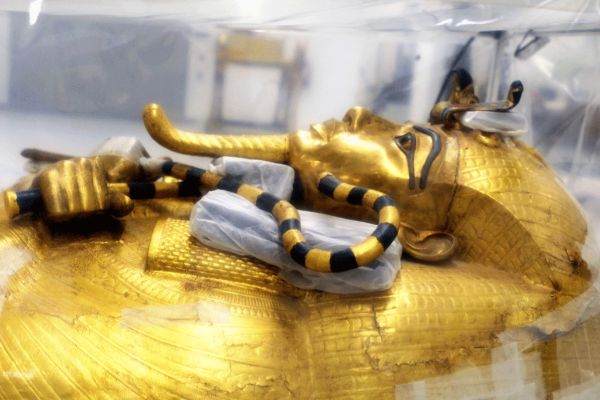- Egypt: Tutankhamen's coffin will enter the operating room for the first time
After 500 kilometers of random journey, escorted by the security forces, the first anthropomorphic coffin of Tutankhamen - the one that remained unredeemed since the discovery of the tomb by Howard Carter in 1922 - a hole has been made in the crowded and modern laboratories of the Great Egyptian Museum, the center that rises a stone's throw from the pyramids of Giza.
Egypt has presented this week in society the beginning of a restoration that will last over the next eight months. A pharaonic task to judge by the worrying results that the preliminary analysis of the sarcophagus has produced, the first of the three that housed the body of the "pharaoh child" and his admired golden mask.
" The coffin is in a very bad state . It had never been restored before and was simply left inside the tomb subjected to moisture, heat and erosion," says Egyptian antiquities minister Jaled el Anani as a medical part. His words are similar to the balance that months ago made public the team responsible for rehabilitating the narrow burial of the pharaoh, now equipped with a breathing system.
Since in the middle of last month the piece landed in the bowels of the museum - whose opening, after a succession of postponements, is set for the end of 2020 -, it was confined in a kind of plastic incubator to protect it from temperature changes. "We made a first aid intervention on the coffin, then we transferred it to the museum. We kept it in isolation for seven days. The fumigation began a few days ago and will last three weeks," details El Anani.
Until July, the sarcophagus - a work of art made of wood, gold leaf, colored glass and semiprecious stones - had remained inside the monarch's tomb, in the Valley of the Kings located in the southern city of Luxor. In the same position, inserted into a space carved in a block of red quartzite and opened by Carter on February 12, 1924.
The one who passes through the operating room is the first of three fascinating anthropomorphic coffins of the monarch who came to the throne with 12 years and died when he was around 20 . The other two that were hidden inside were removed from the place next to the 5,000 objects of the trousseau and exhibited for decades in the Egyptian Museum in the central square of Tahrir.
The first and best known of the sarcophagi, 2.23 meters long, shows Tutankhamen with his arms crossed imitating the pose of the god Osiris, holding in his hands the curved scepter and the scourge and with the symbols of power crowning his forehead .
95 years after its discovery, the coffin is now undergoing its first operation. "Immediate intervention is needed to restore the sarcophagus in a suitable environment," says Eissa Zeidan, director of first restoration and transportation of the Grand Museum. According to the expert, 30% of the coffin is damaged as a result of the high temperatures and humidity that have been recorded for decades in the burial.
"It is in a very bad state, very deteriorated. We have found many cracks and many missing parts and layers," admits Zeidan, in charge of the mission of reviving his battered skeleton, especially damaged in the golden layers of plaster of the lid and base. " There are many fragments. We must now study and determine the original place of each piece so that they are again attached to the coffin," adds Husein Kamal, general director of museum conservation.
After the cleaning process, the restoration will continue with an analysis and a cure of the piece by non-invasive technology . The detached plaster layers will be placed in their original location. As has happened with other elements of the trousseau, such as the carriage or the ritual beds, the restoration can shed light on aspects unknown until now of the composition of the piece or details of its delicate decoration.
Once the operating room phase is over, the coffin will be exhibited in the new museum next to the other two sarcophagi that once housed, in two 7,000 square meter galleries dedicated exclusively to the pharaoh child. "They will be exposed together for the first time since their discovery and as Tutankhamun would have wished," slips El Anani.
The second coffin, christened as the intermediate sarcophagus, is laminated and gilded wood inlaid with polychrome vitreous paste. The lid of the coffin was held by a dozen silver bands. The third, however, is made of solid gold and housed the mummy of the pharaoh and his golden mask, one of the most admired pieces. It weighs 10 kilos . "Tuntakhamun would be the star of any museum. We will show a unique historical object, not only for Egypt but for the entire planet," he concludes.
According to the criteria of The Trust Project
Know more- Science and Health
HealthMore than 500 medications have supply problems in Spain
THREATENED Borneo orangutan falls 30% in 15 years where there is oil palm cultivation
HEALTH Diagnosing and treating cancer as a mathematical error

